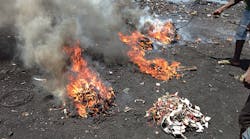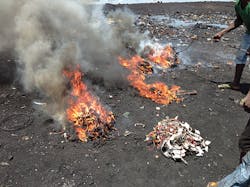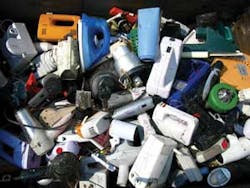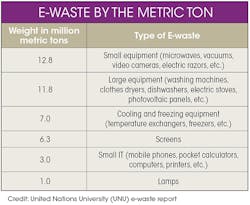Cell phones, tablets, laptops, and other electronic devices are sold by the billions, but when today’s electronics break, become obsolete, or just go out of fashion, most consumers send them to the dump.
The United Nations University (UNU), the research arm of the U.N., defines “e-waste” as all items and parts of electrical and electronic equipment that have been discarded without the intent of being reused. Last year, says UNU, that amounted to more than 40 million tons worldwide.
Without better government oversight and a heightened emphasis on collection and recycling—as well as better design engineering up front and recovery technologies after the fact—the problem of e-waste will only get worse.
Hazardous Substances
The toxicity of e-waste is one of the biggest concerns. Hazardous chemicals associated with electronics include polyvinyl chlorides, mercury, cadmium, chromium, and lead, just to name a few. And when e-waste byproducts leach into ground water, are burned, or get mishandled during recycling, bad things can happen. Health problems associated with such toxins include impaired mental development, cancer, and damage to the lungs, liver, and kidneys.
This file type includes high resolution graphics and schematics when applicable.
This danger is a prime concern of the Electronic TakeBack Coalition (ETBC), which promotes green design and responsible recycling in the electronics industry. According to Barbara Kyle, national coordinator of the organization, “Our focus is on the toxic chemicals in manufacturing consumer electronics, and to push companies to design electronics with recycling in mind. If small changes, like these, are made a lot of the e-waste problems can be reduced.”
Flat screen televisions and monitors containing mercury lamps will likely be the next toxic waste problem that recyclers will have to deal with, says Kyle. Meanwhile, indium—another hazardous substance—continues to be used in flat-panel TVs, smartphones, and tablets. Since those products have been in the marketplace, the medical community has linked such diseases as pulmonary fibrosis, emphysema, and, more recently, pulmonary alveolar proteinosis (PAP), to indium. In most cases it was linked to workers that were exposed to indium compounds in an indium production factory or indium recycling plant.
“Standards and testing on materials should be done before these products hit the market,” said Kyle. “The government should not be relying on the people working for the recyclers and waste management to act as their canary in the mine shaft.”
The Recycling Challenge
According to the EPA, only 15% to 20% of e-waste, in general, gets recycled. Part of the problem is that recycling electronics can be difficult. As Aaron Blum, co-founder and chief compliance officer of Electronic Recyclers International Inc., points out, “Today most e-waste is hand-separated, dismantled, and then shredded for further processing. Using optical separators, magnets, and other techniques that target plastics, copper, precious metals, steel, and aluminum is how we recycle about 99.9% of the materials the company accepts. Most of the metals can also be reclaimed through smelting.”
And so, the question becomes: Is recycling electronics economically viable?
“Companies say their products are recyclable, but the products may not be economically recyclable,” said Kyle of ETBC. “Sometimes just the cost of labor to pay an employee to remove the battery and ship an electronic unit to the smelter is not cost-effective. This can lead recyclers to not accept items that are too costly to process. And the complexity of electronic designs can make the economics of recycling harder.”
She added, “Engineers and policy makers need to pay attention to the economic recyclability, not the theoretical recyclability of products.”
One possible solution for e-waste would be on the consumer: electronic items at retail would be marked with a cradle-to-grave price tag. Variations of these Advanced Recycling Fees (ARFs) have cropped up in Japan, Switzerland, Belgium, and South Korea, as well as parts of Canada and California. This fee is paid at the point-of-purchase by the consumer to help defray the cost of proper disposal of the item once the purchaser no longer wants it.
But would it work? Advocates point to success in Japan, where the ARF has led to e-waste recycling rates of approximately 75% for products covered under the home appliances recycling law. Kyle disagrees, however, that it’s not just the ARFs that have led to high recycling rates there. “The more important concept there is that laws also require retailers and manufacturers to play a role in recycling their old products. ARF is just a funding mechanism. Producer Responsibility and cost internalization is another approach that is working in some US states and in Europe.”
It is also important to recycle through reputable, properly accredited vendors. According to Kyle, “Sometimes criminals will hold a fund raiser and even find a reputable local charity to do the work for free. The ‘recycler’ then pockets the money paid to properly recycle the material and instead ships the e-waste overseas.”
People can be misled when they hear a recycler has an EPA number or is ISO14001 compliant. Every recycler has an EPA number. Being ISO 14001 compliant is a standard for how to design an environmental management program. Neither of the aforementioned indicates that a recycler is acting responsibly or being held accountable for proper practices. Even a Responsible Recycling (R2) certification could be misleading. R2 certification ensures that a recycler is practicing proper safety standards for its employees, but a certified recycler could still export or use municipal landfills and incinerators to dispose of e-waste.
New Technology
When it comes to issues surrounding e-waste and recycling, disposal of batteries often takes center stage—which makes sense, considering that 330,000 tons of batteries were disposed of globally last year alone according to the UNU report. As discussion of battery waste grows, the development of more environmentally friendly batteries is gaining some traction in the marketplace. Two types being talked about are aluminum-ion and bio-batteries.
The aluminum-ion batteries that are being developed reduce toxins and increase the batteries’ value to recyclers. Aluminum is valuable to recycle and, during use, reduces the chance of thermal runaway. The voltage is said to be low, but even having the ability to replace alkaline batteries and be easy to recycle would make a large difference for e-waste. Batteries being developed may someday be used in laptops and cellphones, but for now aluminum-ion are more likely to replace AA and AAA batteries. However, there is no date of when this technology might be seen in the consumer market.
Glucose bio-batteries would take environmentally friendly batteries a step farther. Though still in development, Y-H Percival Zhang, Ph.D. at Virginia Tech, has created a prototype power bank with an output of 5 V and a current of 1 A. The first application of the metal-free power bank will be to charge cellular phones. What’s unique about these numbers is that they are from one device containing about 30 grams of sugar that would have enough energy to charge the average smartphone from four to five times. In experiments, a maltodextrin solution was used to cause an enzyme cascade. By using multiple enzymes, a biochemical reaction in the form of an electron flow occurs. This type of bio-battery provides a sustainable, environmentally friendly battery.
“A polysaccharide, which is more of a starch consisting of sugar, is capable of converting this starch into 24 electrons from a single glucose molecule,” said Zhang. “The enzymes are designed to slowly release the energy from the sugars. Experimental batteries started with an output of only 1 mW/cm^2 in the lab. We have quickly redesigned them to produce 3 mW/cm^2, and there is a lot of room to improve.” He added, “Sony has mentioned having sugar batteries capable of up to 10 mW/cm^2.”
The research from Virginia Tech uses 13 enzymes containing a 15% weight /volume mix of a maltodextrin solution with a density of 596 Ah kg -1 , which is one magnitude higher than lithium. Zhang noted, “It is possible to start experimenting with hybrids and different proteins to alter properties to increase the scope of the applications of this technology.”
Zhang believes the battery market will realize the potential for bio-batteries with high density and no risk of fire, explosion, or toxins and be willing to adopt the new technology. He is also confident that the process to produce this type of battery will scale easily. Like the aluminum battery, this will only allow a small, consistent flow of energy that will be good in small electric components. This means neither of these technologies—aluminum ion or bio-batteries--will be capable of powering electric cars, for instance.
Award-winning designs
While there is a growing call from environmentalists and other interested parties for legislation to address e-waste concerns, some manufacturers are addressing the problem without government mandates.
For instance, in 2014 Dell won the Design for Recycling (DFR) Award, presented annually by the Institute of Scrap Recycling Industries (ISRI). The Latitude XPS 10 tablet, Latitude E7240 laptop, and the Latitude 10 tablet from Dell received the award for the clear labeling of parts for identification, minimal use of glues and adhesives, and convenient disassembly guides that should make these products easier to recycle.
This year, ISRI named LG Electronics the recipient of the DFR award for its 4K ULTRA HD OLED and LED TVs. The company was recognized for the televisions’ mercury-free display panels, recycled and recyclable plastics, inclusion of PVC and BFR-free components, small and lighter packaging, ease of disassembly and label/seal separation, and standardized materials and connection types ..
Google is working on a modular smartphone, which some industry experts see as potentially more environmentally friendly. Its Project Ara is a customizable smartphone with various add-ons that can slide into a universal style backbone. When a component is no longer wanted or broken, it is possible to replace the individual component. This could reduce the amount of the phone’s potential e-waste.
Electronic Waste by the Numbers
· Around 6.5 million tons of e-waste was reported as formally treated by national take-back systems.
· Most of the world’s e-waste in 2014 was generated in Asia--16 million tons (8.2 lbs. per inhabitant).
· The highest per inhabitant e-waste quantity (34.4 lbs. pre inhabitant) was generated in Europe (including Russia) with 11.6 million tons.
· The Americas generated 11.7 million tons of e-waste, or an average of 26.9 lb. per inhabitant.
Many view E-waste is a nuisance at best, but value can be in the eye of the beholder. UNU reported that the various materials found in E-waste in 2014 alone are worth around $52billion. The UN experts said $10.66 billion of that was just in gold.
Likewise, the EPA says one metric ton of circuit boards can contain 40 to 800 times the amount of gold and 30 to 40 times the amount of copper mined from a single metric ton of ore in the United States.
This file type includes high resolution graphics and schematics when applicable.




